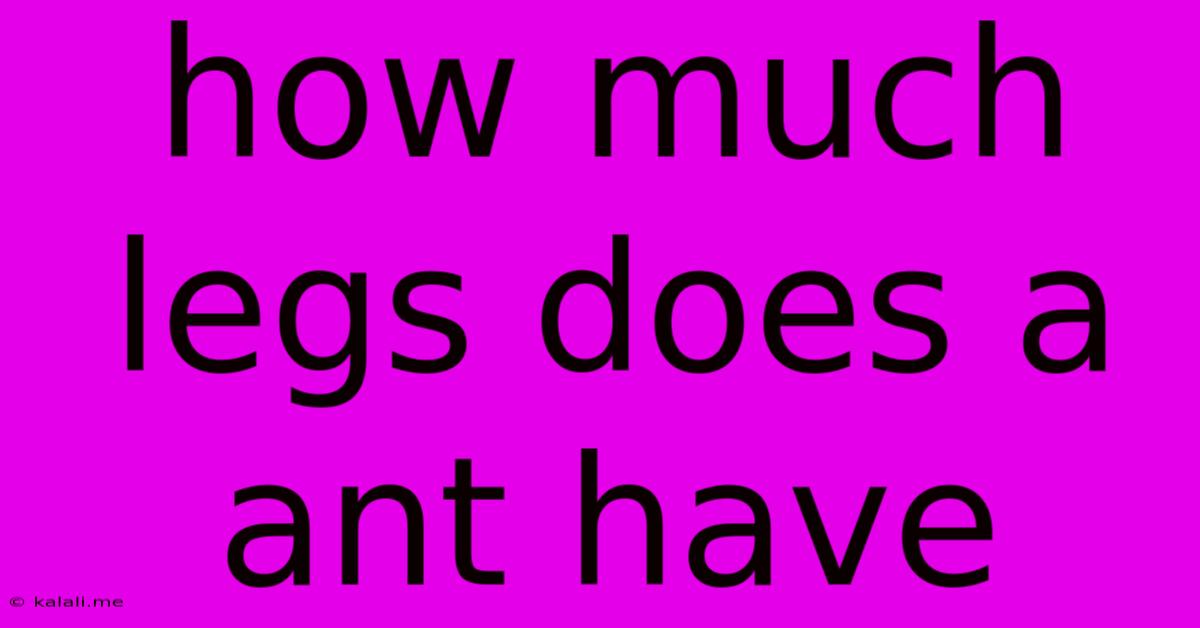How Much Legs Does A Ant Have
Kalali
Jun 13, 2025 · 3 min read

Table of Contents
How Many Legs Does an Ant Have? A Comprehensive Guide
Meta Description: Discover the answer to the age-old question: how many legs does an ant have? This comprehensive guide delves into ant anatomy, exploring their six legs and their incredible capabilities. Learn about the functions of ant legs and their role in survival.
Ants are fascinating insects, ubiquitous in almost every corner of the globe. Their intricate social structures and tireless work ethic have captivated scientists and nature enthusiasts for centuries. But one question frequently pops up, especially among children: how many legs does an ant have? The simple answer is six.
Ant Anatomy: The Six-Legged Wonder
All insects belonging to the order Hymenoptera, which includes ants, bees, and wasps, share a characteristic body plan. This plan includes three distinct body sections: the head, thorax, and abdomen. Crucially, the thorax is where the legs are attached. Each ant possesses three pairs of legs, one pair attached to each of the three segments of the thorax. This gives them a total of six legs.
The Amazing Capabilities of Ant Legs
While the number of legs might seem straightforward, the capabilities of an ant's legs are far from simple. These tiny appendages are incredibly powerful and versatile, enabling ants to perform a remarkable range of tasks essential for their survival.
-
Walking and Running: Ant legs are designed for efficient locomotion. Their structure allows for swift movement across various terrains, including rough surfaces and even vertical climbs. The tiny claws at the end of their legs provide grip and traction, allowing them to navigate complex environments.
-
Carrying Heavy Loads: Ants are known for their strength, often carrying objects many times their own weight. Their leg structure and powerful muscles work in coordination to achieve this feat. The design allows for precise and stable positioning when handling objects.
-
Sensing: Ant legs are equipped with sensory organs, including chemoreceptors that detect chemical cues, helping them navigate, find food sources, and communicate with other ants within their colony. This sensory input is crucial for their survival and colony maintenance.
-
Cleaning: Ants use their legs to clean their antennae and bodies, maintaining hygiene within the colony. This is a vital aspect of preventing the spread of diseases and parasites.
Distinguishing Ants from Other Insects
Knowing that ants have six legs helps distinguish them from other insects. While many insects have six legs, certain physical characteristics help identify an insect as an ant specifically. Look for features such as their:
- Elbowed antennae: Ant antennae are characteristically bent or elbowed.
- Narrow waist: Ants have a distinct narrow waist between the thorax and abdomen (the petiole).
- Size and Shape: Ants generally have a relatively small size and a specific body shape.
This combination of characteristics, together with the presence of six legs, allows for accurate identification.
Conclusion: Six Legs, Endless Wonders
The answer to the question "How many legs does an ant have?" is a simple yet profound one. The six legs of an ant are not just appendages for walking; they are sophisticated tools that enable these tiny creatures to thrive. Understanding their anatomy highlights the marvel of nature's engineering and the incredible adaptability of insects. Their abilities, supported by these six legs, contribute to the vital roles they play in ecosystems worldwide.
Latest Posts
Latest Posts
-
Which Of The Following Is Not Part Of The Brain
Jun 14, 2025
-
What Can 51 Be Divided By
Jun 14, 2025
-
What Occupies Space And Has Mass
Jun 14, 2025
-
The Sum Of Two Irrational Numbers Is
Jun 14, 2025
-
What Is The Difference Between An Article And A Journal
Jun 14, 2025
Related Post
Thank you for visiting our website which covers about How Much Legs Does A Ant Have . We hope the information provided has been useful to you. Feel free to contact us if you have any questions or need further assistance. See you next time and don't miss to bookmark.